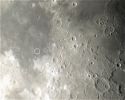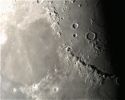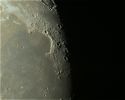 NEW! Image by Ron Brown
NEW! Image by Ron BrownDuring the last week of October 2014 a huge sunspot appeared. The complex was larger than the planet Jupiter and was visible to the naked eye. This photo was taken with a cell phone looking into a 20 mm eyepiece plugged into a 114 mm f8 Celestron Starseeker telescope.
I've been learning how to do more with Registax to process images from my Orion Starshoot 3 camera. Below are several images taken during late May and early June 2012. All of the pictures were taken with the camera mounted in a diagonal, so they are all mirror-reversed.
 Venus
at about 8:50 PM on May 31, 2012. On June 5, Venus will cross the
face of the sun. Since Venus is now very close to the sun in the
sky, it appears as a thin crescent in a telescope eyepiece.
This photo was taken from the Mountain Ridge High School parking
lot, which is one of the locations where we plan to observe the
beginning of the transit. The photo was taken with a
Canon 40D on a Celestar 8 f10 sct.
The exposure was 1/320 sec at ISO1600. The camera was tilted, so
this image was cropped from the full frame and rotated so the horizon
was horizontal.
Venus
at about 8:50 PM on May 31, 2012. On June 5, Venus will cross the
face of the sun. Since Venus is now very close to the sun in the
sky, it appears as a thin crescent in a telescope eyepiece.
This photo was taken from the Mountain Ridge High School parking
lot, which is one of the locations where we plan to observe the
beginning of the transit. The photo was taken with a
Canon 40D on a Celestar 8 f10 sct.
The exposure was 1/320 sec at ISO1600. The camera was tilted, so
this image was cropped from the full frame and rotated so the horizon
was horizontal.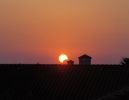 This
picture of the early stages of the annular eclipse of May 20, 2012, was
sent to us from Houston, TX by Xi Chen, a former Frostburg State
University student.
This
picture of the early stages of the annular eclipse of May 20, 2012, was
sent to us from Houston, TX by Xi Chen, a former Frostburg State
University student.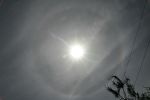 Image by Steve Luzader
Image by Steve LuzaderA 22 degree circumsolar halo observed around noon on May 12, 2012. I was surprised to see this in the spring. These halos are caused by ice crystals high in the atmosphere, and the only other time I've ever seen one was on a brutally cold December day in the 1980s as I was driving through Chicago. The picture was taken with a Canon 40D with a 17 - 50 mm lens set at 17 mm. The exposure was 1/1600 s at f20, ISO 400.
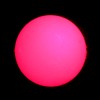 Image by Steve Luzader
Image by Steve LuzaderSolar prominences photographed on July 19, 2011, through a Meade SolarMax 60 telescope. A Canon 40D with a 28 - 135 mm zoom lens set at 28 mm pointed into an 18 mm eyepiece. The exposure was 1/250 sec at f13, ISO 800. The image was cropped from the full frame and was enhanced to bring out details that were visible in the eyepiece. In addition to the prominences on the limb, a prominence erupting toward earth can be seen near the center of the disk as a dark sinuous feature. The lighter area near that prominence was a large sunspot complex seen in visible light.
 Image by Mark Rudy
Image by Mark RudyThe feaure at the southwestern edge of Sinus Iridum known as Promontorium Heraclides, but which is also called "The Lady in the Moon" as related in the September 2010 issue of Sky and Telescope. The image was taken at Stars in the Park on Saturday, June 11, 2011, at the Glendening Recreation Complex in Frostburg, MD, with an Orion Starshoot IV imager attached to a 12.5"f5.4 Newtonian. Approxmiately 50 frames were processed with Registax 5 to create the final image.
 Image by Mark Rudy
Image by Mark RudyThe crater Copernicus with Rheinhold and Lansberg below. The ray system is prominent in the image, which was taken on April 14, 2011 with an Orion Starshoot IV imager attached to a 12.5"f5.4 Newtonian. Approxmiately 100 frames were processed with Registax 5 to create the final image.
 Image by Mark Rudy
Image by Mark RudyThe craters Aristoteles and Eudoxus, with Plato shadowed on the terminator. Montes Alpes and Vallis Alpes are prominent because of the sun angle. The image was taken with an Orion Starshoot IV imager attached to a 12.5"f5.4 Newtonian. Approxmiately 150 frames were processed with Registax 5 to create the final image.
 Image by Mark Rudy
Image by Mark RudyThis sunspot group was photographed at about 3 PM on March 12, 2011 with an Orion Starshoot IV imager. The exposure was 7 seconds at 30 frames per sec. The resulting 2100 frames were processed with Registax 5. The telescope is a homemade 12.5 inch f5.4 Newtonian masked to 4 inches with a homemade Bader filter.
 Images by Steve Luzader
Images by Steve LuzaderThese images were taken on Oct. 27 and 28, 2010. Compare them with the Oct. 24 image below. The pair of sunspots has been joined by a larger spot, which moves from one day to the next. Each picture is a superposition of three images taken through my 80 mm f7.5 apochromat fitted with a homemade filter. From the Oct. 27 image, I estimate the diameter of the largest spot to be just under 31,000 km, or about 2.5 times the diameter of the earth.
 Images by Steve Luzader
Images by Steve LuzaderThese images, taken on Oct. 22 and 24, 2010, show our dynamic sun. Three sunspots were observed on Oct. 22. The next day, when CAC was participating in the Science and Engineering Festival on the FSU campus, we saw that several smaller spots had appeared near the large one at the apex of the triangle in the Oct. 22 image. On Oct. 24, a new large spot had appeared at the apex and a pair of smaller spots could be seen between the apex and the spot at the upper left of the triangle. (And of course the entire group is moving as the sun rotates.) Both images were taken with a Canon 40D SLR. The Oct. 22 picture was taken through my 80 mm f4 ShortTube refractor, and the Oct. 24 picture was taken through my 80 mm f/7.5 apochromat. The Oct. 24 image was reduced by 2/3 to match the scale of the Oct. 22 image. While observing the sunspots, we also looked at a large prominence through FSU's PST40. Within less than 30 minutes, that prominence had completely disappeared!
 Image by Steve Vincent
Image by Steve VincentThis is an eyepiece view of the sun at H-alpha wavelength taken through a Coronado PST40 on Sept. 11, 2010, during Astronomy Weekend at Blackwater Falls State Park in Davis, WV. A large prominence is visible. Careful observers noted significant changes in the prominence over a period of an hour or so.
 Images by Steve Luzader
Images by Steve LuzaderAfter a long period of quiescence, sunspots are returning. Clicking on the thumbnail will bring up a sequence of images taken on Sept. 22, 23, and 24, 2010. You can see how the spots move across the face of the sun. The lower spot has changed shape during the three day period. Click here to see a sequence of closeups showing the evolution from a spot with two distinct umbrae to a single umbra that looks like Mickey Mouse. Measuring the size of the spot in the image allows me to infer that the spot is about 40,000 km wide by about 28,500 km tall. That means six earths could fit into it!
The images were taken through an 80 mm Orion ED refractor with a homemade filter. The Sept. 22 image was taken with a digital point-and-shoot camera looking into the eyepiece. The other images were taken with a Canon 40D SLR attached to the telescope. The filter was made by cutting a hole in a plastic bowl that just fits over the end of the telescope and taping a piece of Baader solar filter material over the hole. Works quite well!
 Image by Mark Rudy
Image by Mark RudyThis is an eyepiece view of the chain of sunspots in the Sun's northern hemisphere visible in the photos above. The image is a combination of two shots taken with a Fuji digital camera set for 1/250 sec at f4.2, ISO 400, at a focal length of 71.2 mm. These pictures were taken on Sept. 25, 2010.
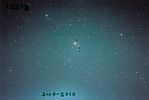 Image by Gus Johnson
Image by Gus Johnson
Asteroid Vesta passing Gamma Leo on 2/14/2010. The exposure was 42 seconds with a 135 mm lens at f2.8 on ASA 800 color negative film. Alt-azimuth tracking was used.
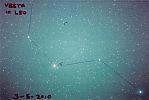 Image by Gus Johnson
Image by Gus Johnson
By March 5 Vesta was near the center of the "sickle" in Leo. Regulus is the bright star in the lower right corner. The exposure was 60 seconds with a 135 mm lens at f2.8 on ASA 800 color negative film. Alt-azimuth tracking was used.
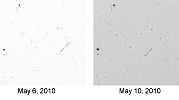 Images by Steve Luzader
Images by Steve Luzader
This pair of images shows the motion of Vesta in Leo from May 6 to May 10, 2010.
The images are presented as negatives to make the asteroid easier
to see. Algieba is the bright star at the left edge of each image.
Vesta's direction of motion relative to the stars has reversed
since Gus Johnson's pictures were taken in February and March.
Note the asterism just above and to the right of Algieba--it
looks like a tiny Leo within Leo. The pictures were taken with a
piggyback-mounted Canon 40D using a 28 - 135 mm lens at 28 mm and f3.5
at ISO1600. The images shown were cropped from the full frame.
The May 6 exposure was 1 minute, and the May 10 exposure was 2
minutes.
 Image by Steve Luzader
Image by Steve Luzader
This sequence of images shows the July 22, 2009 total solar eclipse
viewed from the south end of the Hangzhou Bay Bridge south of Shanghai
near Hangzhou, China. The weather conditions were terrible and we
viewed the eclipse through clouds and rain. The camera used was a
Canon 40D with a 28 - 135 mm image stabilized zoom lens set for a focal
length of 135 mm. The "Before" expose was 1/250 s @ f8.0,
ISO 1000. The totality image is a composite of four images taken at 1/30 s @ f3.5, ISO 3200. The "After" exposure was 1/640 s @ f5.6,
ISO 3200. The inner corona is actually visible through the clouds and rain.
 Image by Mark Rudy
Image by Mark RudyThe region around Copernicus on the moon. The image is a stack of four separate exposures processed with Registax. The view is inverted as seen in the eyepiece of a Newtonian telescope.
 Image by Steve Luzader
Image by Steve LuzaderA composite of two digital camera images taken about 40 minutes apart showing the region around the Apollo 17 landing site on the moon. The circle in the left-hand image marks the approximate region where the crew landed. Note how the shadow cast by Mons Argaeus shorted during the interval between the exposures. The large crater at the top is Posidonius. These images have been adjusted to show the correct orientation. The actual eyepiece view was the mirror image of what is shown.
 Image by Steve Luzader
Image by Steve Luzader
A digital camera shot of the region around the Apollo 15 landing site,
indicated by the white circle. The large flat-bottom crater is
Archimedes, and the mountain range is the Appenines. The image
has been adjusted to show the correct orientation. The actual
eyepiece view was the mirror image of what is shown.
 Image by Mark Rudy
Image by Mark Rudy
This is a montage of images showing the totally eclipsed moon, Saturn,
and Regulus on February 20, 2008. The camera is a Nikon
E8700V. The individual exposures were 2 sec with the lens set for
a focal length of 25.4 mm at f/3.6.
A total of seven images were taken from 10:22 PM EST to 10:50 PM EST at
5 minute intervals. Note that since the moon is not centered in
the earth's shadow, the brightness varies across the lunar disk.
The brightest part of the disk shifts as the shadow moves.
To help keep track of the relative positons of Saturn and
Regulus, here are links to two pictures showing just the first image
with Saturn to the left and below the moon with Regulus above the moon,
and a second picture with the moon, Saturn, and Regulus identified in
the first exposure. Image 1 Annotated Image
 Photo by Steve Luzader
Photo by Steve Luzader
A photo of the lunar eclipse in the early morning of August 28, 2007. This
photo was taken around 5:50 AM. The exposure was 1/2 second on ASA 800 film
using a zoom lens set at 270 mm/ f/5.6. The sky was pretty gray at
the time.
 Photo by Steve Vincent
Photo by Steve Vincent
A photo of the lunar eclipse in the early morning of August 28, 2007.
The moon is about half covered, with the penumbral part looking
distinctly coppery. The photo was taken with a Kodak digital
camera.
 Photo by Mark Rudy
Photo by Mark Rudy
A photo taken October 21, 2007, of the moon rising over Seneca Rocks in WV.
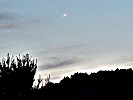 Photo by Steve Vincent
Photo by Steve Vincent
Mercury, Venus, and Saturn on June 27, 2005. Venus and Mercury are very close
at the top center, and Saturn is barely visible just above the trees in the
lower center of the photo. This image was cropped from the original taken
with a digital camera, and then the contrast was enhanced to bring out Saturn.
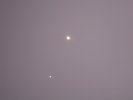 Photo by Steve Vincent
Photo by Steve VincentAn eyepiece projection image of Venus and Mercury taken with a digital camera looking into a 25 mm eyepiece. The gibbous shape of Venus can easily be seen.
 Photo
by Steve Luzader
Photo
by Steve Luzader
My first photo of the 2004 Venus transit, taken about 6:36 AM on June 8 from
the Glendening Recreation Complex in Frostburg. The sun was rising behind
some trees. The exposure was 1/500 sec on Fuji Superia 800 film using my 80
mm f/4 Shorttube refractor fitted with an aluminized glass solar filter.
 STV
image by Steve Luzader
STV
image by Steve Luzader
This image of the Venus transit was taken at approximately 7:10 AM with my
STV camera fitted to the Shorttube refractor. While it may not be easily visible
in the image on the computer screen, the "teardrop" effect can be
seen developing.
 Photo
by Steve Luzader
Photo
by Steve LuzaderThis is one of my last photos, taken at about 7:17 AM. Venus now looks like a notch on the limb of the sun. The exposure information is the same as for the first color photo.
 Image by Steve Luzader
Image by Steve Luzader
Mars as seen about 11 PM on September 24, 2003. The image is comprised of
several STV exposures taken through a red filter, then processed and combined
with AIP4WIN. During the time that elapsed since the September 10 image, the
opposite hemisphere of Mars has rotated into view. The polar cap can be
seen clearly.
 Image
by Steve Luzader
Image
by Steve LuzaderMars as seen about 11 PM on September 15, 2003. The image is comprised of 14 STV exposures processed and combined with AIP4WIN. Because the Martian day is about half an hour longer than an earth day, observing at the same time every night brings a slightly different part of the surface into view. Mare Cimmerium has moved to the west edge of the disk, and Tharsis (location of three huge volcanos) is visible at the eastern edge. This picture is larger than the one from September 10 because only the central quarter of the STV frame is used.
 Image
by Gus Johnson
Image
by Gus Johnson
For comparison with the CCD image below, here is a sketch made by Gus Johnson
at about the same time. South is up in the drawing. Features visible are identified
beside the sketch.
 Image by Steve Luzader
Image by Steve LuzaderMars as seen about 11 PM on September 10, 2003. The image is comprised of 14 STV exposures processed and combined with AIP4WIN. By using a 2X Barlow, my 8-inch SCT was operating at f/20. The orientation is true, with north up and east to the right. Syrtis Major is visible at the far west side, with the Hellas impact feature visible just below Syrtis. The southern polar cap, which had shrunk dramatically over two weeks of observing, is visible. Click here to see a picture identifying some of the features that can be seen.
 Image
by Steve Luzader
Image
by Steve Luzader
Mars as seen about 11 PM on September 6, 2003, at a Mars observing session
at the Glendening Recreation Complex in Frostburg.. The image is comprised
of 14 STV exposures processed and combined with AIP4WIN. My 8-inch SCT was
operating a f/10, and the STV image was read out in Zoom mode (one quarter
of the full STV frame. The orientation is true, with north up and east to
the right. Syrtis Major is in the center, with the Hellas impact feature visible
just below Syrtis. The southern polar cap is visible.
 Image
by Gus Johnson
Image
by Gus Johnson
Here is a sketch made by Gus Johnson on August 20. Information is included
in the image.
 Photo
by Gus Johnson
Photo
by Gus Johnson
The moon and Mars photographed at 5 AM EDT on July 17, 2003. The photo was
1/125 sec on ASA 800 film using a 6-inch reflector with eyepiece projection
(about f/10).
A group of sunspots photographed by eyepiece projection. The magnification is 30x and the exposure was 1/125 second on Ektachrome 100 slide film.
 Photo
by Steve Luzader
Photo
by Steve Luzader
Mars and the globular cluster M19, which have been very close during June
and July of 2001. This photo was taken on July 12, a few days after Mars'
closest approach to M19. The exposure was 10 minutes on Fujicolor Superia
400 color negative film. The camera was attached to my 80 mm f/4 "Shorttube"
refractor riding piggyback on my 8" SCT. The displayed image was cropped
from the negative and rotated to show the scene roughly as it would appear
in binoculars.
 Photo
by Steve Luzader
Photo
by Steve Luzader
Mars and Antares, taken the same night as the picture of Mars and M19 above.
This piggyback photo was a 3 minute exposure with a 50 mm lens at f/2. The
globular cluster M4 is visible to the west of Antares, below Sigma Scorpii.
M19 is barely visible above Mars. The color of this image was adjusted in
Paint Shop Pro because the southern sky is tinted strongly green by a street
light that pollutes the southern sky as seen from our home in Frostburg.
 Image
by Steve Luzader
Image
by Steve Luzader
Jupiter with its Red Spot imaged by an SBIG ST-V CCD camera. The picture
was taken January 22, 2001, with an 8-inch SCT at f/20 using a 2X Barlow.
The image was resampled to a larger size and the contrast and sharpness were
enhanced using AIP4WIN. Unfortunately, I missed the Red Spot's transit across
the meridian by over an hour, so it is visible near the planet's limb.
 Image
by Steve Luzader
Image
by Steve Luzader
This image of Saturn was captured with an SBIG ST-V CCD camera. The
telescope was an 8-inch SCT operating at f/20 using a 2X Barlow. The
image was resampled to a larger size and the contrast and sharpness were enhanced
using AIP4WIN.
 Image
by Steve Luzader
Image
by Steve Luzader
This is an STV image of the sun taken at approximately 2:15 PM EST
on December 24 in Frostburg, MD. Note the large group of sunspots
near the center of the sun's disk. The telescope used was an Orion
80 mm f/5 "Shorttube" refractor fitted with an aluminized glass solar filter.
 Image by Steve Luzader
Image by Steve Luzader
This is an STV image of the sun showing the same group of sunspots just after the disk of the moon had crossed during the solar eclipse on Christmas Day, 2000. The image was made at approximately 1:12 PM in Salem, WV. The camera wasn't attached to the telescope in the same orientation as the previous image, so this picture was rotated to more closely match the earlier one. The dark area in the image is an artifact probably caused by "blooming" in the CCD chip. The telescope used was an Orion 80 mm f/5 "Shorttube" refractor fitted with an aluminized glass solar filter.
 Images
by Steve Luzader
Images
by Steve Luzader
Clicking on the thumbnail brings up a montage of three STV images of the Christmas 2000 solar eclipse. The images were captured over a 6-minute interval as the disk of the moon uncovered a large group of sunspots. The approximate times are given below each image. The camera was removed between the second and third images, so the third image was rotated to have the same orientation as the other two. The eclipse was observed in Salem, WV. The telescope used was an Orion 80 mm f/5 "Shorttube" refractor fitted with an aluminized glass solar filter.
 Image
by Steve Luzader
Image
by Steve Luzader
For Christmas 2000, my wife and daughter presented me with a wonderful new toy--an SBIG ST-V CCD imager/autoguider. It arrived on December 12, 2000, and I tried it out that evening in spite of temperatures below 20 F. This picture of the moon is the first image I took with the STV. The picture was taken with the camera attached to my 80 mm "Shorttube" refractor (with no clock drive). The exposure was 1 millisecond with a 20X filter in front of the CCD.
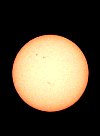 Photos
by Steve Luzader
Photos
by Steve Luzader
Clicking on the thumbnail brings up a composite of three images of
sunspots photographed on July 7, 8, and 9, 2000, at approximately the same
time each afternoon. The exposure for each was 1/500 sec on Fujicolor 200
negative film using an Orion 80 mm Shorttube refractor fitted with an Orion
metallized glass solar filter. Note the movement of the sunspots from day
to day, as well as the rapid appearance of a large group of new spots between
July 7 and July 8. Note how the rotation of the sun has carried a large
sunspot into view between July 8 and July 9. The sun was partially obscured
by thin clouds on July 9.
 Photo
by Andy McCleary
Photo
by Andy McCleary
The total solar eclipse of Feb. 28, 1998, photographed from a ship
in the Caribbean.
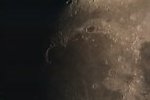 Photo
by Gus Johnson
Photo
by Gus Johnson
Plato and Sinum Iridum. The eyepiece projection photo was made with
an 8" Newtonian reflector at about f/30 on Kodak DX ASA400 color negative
film.
 Photo
by Steve Luzader
Photo
by Steve Luzader
Near first quarter moon photographed by eyepiece projection. North
is up in this picture. A 26 mm Plossl eyepiece was used in a Celestron
8" SCT. The exposure was about 1 sec on Fujichrome Sensia 100 slide film.
The "shutter" was a large piece of cardboard held in front of the telescope,
yanked away and quickly put back. This view extends from the north pole
to just south of the lunar equator. The circular mountain chains which
border Mare Imbrium are the lunar Alps near the top and the Apennines below
them. Apollo 15 landed in the highlands on the western side of the Apennines
near the end of the mountain chain. The prominent crater in Imbrium near
the terminator is Copernicus. Just south of the equator is a chain of three
craters, the largest of which is Ptolemaeus. Closeup views of the Alps
and Ptolemaeus are offered below.
 Photo
by Steve Luzader
Photo
by Steve Luzader
First quarter moon photographed by eyepiece projection with a 10 mm
eyepiece in a Celestron 8" SCT. The exposure is about 1/2 sec on Konica
3200 film. North is up in this picture. The large crater at the top is
Ptolomaeus, and Mare Nubium is the smooth region in the left side of the
picture. The Ranger 9 space probe crashed just northeast of the central
peak in Alphonsus, the crater just below Ptolomaeus.
 Photo
by Steve Luzader
Photo
by Steve Luzader
First quarter moon photographed by eyepiece projection with a 10 mm eyepiece in a Celestron 8" SCT. The exposure is about 1/2 sec on Konica 3200 film. North is up in this picture. Plato is the large crater near the center of the image, and the dark area on the west side of the picture is Mare Imbrium. The straight feature east of Plato is Vallis Alpes, which cuts through Montes Alpes.
![]() Photo
by Steve Luzader
Photo
by Steve Luzader
First quarter moon photographed by eyepiece projection. South is up
in this picture. A 10 mm Vixen LV eyepiece was used in a Celestron 8" SCT.
The exposure was about 1/2 sec on Konica 3200 film. The "shutter" was a
large piece of cardboard held in front of the telescope, yanked away and
quickly put back. The large crater about a third of the way down from the
top of the image is Clavius, while the small crater with the prominent
peak about a third of the way up from the bottom is Tycho.
 Photo
by Bob Doyle
Photo
by Bob Doyle
A short exposure taken during the March 1997 partial lunar eclipse.
The fixed tripod exposure was made with a 135 mm lens at f/1.8 (yep, f/1.8!)
on Seattle Film Works ASA 400 slide/print film. The image was cropped and
enlarged from a slide.
 Photo
by Bob Doyle
Photo
by Bob Doyle
A longer exposure of the March 1997 partial lunar eclipse. The image is from
a slide.
 Photos
by Steve Luzader
Photos
by Steve Luzader
This pair of images shows Venus in its gibbous and crescent phases. Seeing Venus going through a cycle of phases like the Moon helped convince Galileo that the planets in the solar system were orbiting the sun, not the earth. Both photos are by eyepiece projection using a 10 mm eyepiece in an Orion adjustable telextender at maximum length for greatest magnification. The resulting small image on the 35 mm slide was cropped and enlarged for display. Both exposures were about 1/2 second and were made by holding a large piece of cardboard in front of the telescope to act as a shutter. The cardboard was yanked away and put back as quickly as possible. The gibbous phase was photographed Oct. 3, 1997, on Ektachrome 100 film. The crescent phase was taken Dec. 28, 1997 on Fujichrome Sensia 100 film.
 Photo
by Bill Sherman
Photo
by Bill Sherman
Jupiter photographed by eyepiece projection. A 9 mm eyepiece was used
in an 8" Meade SCT to form an image on Fujicolor 400 film. The exposure
was determined automatically by the camera.
 Photo
by Steve Luzader
Photo
by Steve Luzader
This piggyback photo shows Jupiter, Venus, and Mars at about 6 PM EST on Dec. 16, 1997. Jupiter is in the upper left corner of the image, Venus is the very bright object, and Mars is to the right of Venus, about a third of the way up from the bottom. The image is tilted because of the orientation of the camera on the guiding telescope. These bright planets were lined up just below the ecliptic that evening. Neptune (magnitude 8) was just to the west (right) of Mars, but is lost in the skyglow. Uranus was about a third of the way between Venus and Jupiter, and a check of the stars with the program Red Shift showed that Uranus (magnitude 5.9) was indeed captured in the image. It's circled in the photo. The exposure was 5 minutes with a 55 mm lens at f/2.8 on Fujichrome Sensia 100 film.
 Photo
by Bill Sherman
Photo
by Bill Sherman
Saturn photographed by eyepiece projection. A 9 mm eyepiece was used in an 8" Meade SCT to form an image on Fujicolor 400 film. The exposure was determined automatically by the camera. The image shown was cropped from a small portion of a print, causing the displayed image to be a little grainy. The print was also very light, so the brightness and contrast were changed for the displayed image.
